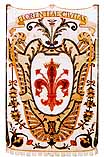
Mosaic with the
coat-of-arms of Florence
Part
One 
The Second Republic was founded, with Gonfalonier Piero Soderini at its
head, after the death of Lorenzo il Magnifico (1492) and the expulsion of
his son Piero (1494): when Charles VIII invaded Italy (1494), the city,
led by Pier Capponi, held out against the French ("if you play your
trumpets, we will ring our bells"). The Dominican preacher, Savonarola,also attempted to give Florence a more
popular and theocratic rule. His republic was formed of eight Priors, one
principal Gonfalonier and sixteen minor Gonfaloniers of the Companies, a
main Council (formed by all Florentines of over 27 years of age): The so-called
Hall of the Five Hundred inside Palazzo Vecchio -
seat of the Florentine government since the early 14th century - was built
to hold the assemblies.
The Second Republic did not end in 1498 with Savonarola, falsely accused of heresy,
being burned at the stake but continued, partly thanks to the contribution of
Niccoló Machiavelli, until 1512, when the flight of Gonfalonier Soderini
before the armies of the Viceroy of Naples left the field free for the return
of the Medici family, with Giovanni and Giuliano, the
sons of Lorenzo the Magnificent, and their cousin Giulio, the illegitimate son
of Giuliano, murdered in the Pazzi plot.

Savonarola at the stake
Giovanni was elected Pope in 1513 under the name of Leo X and the government of Florence passed to Giulio, himself elected Pope in 1523 under the name of Clement VII. When he departed for Rome, the Pope left the city in the hands of his young son Alessandro and his cousin Ippolito, under the guidance of Cardinal Passerini. The "Sack of Rome" in 1527, which saw Clement VII besieged in Castel Sant'Angelo, led the Florentines to hope that they could reinstate the Republic. The Medici family was again driven out and Niccoló Capponi was elected Gonfalonier but the dream only lasted until 1530, when Florence was defeated by Charles V, the ally of the Medici Pope. Alessandro became the first Duke of Florence.
